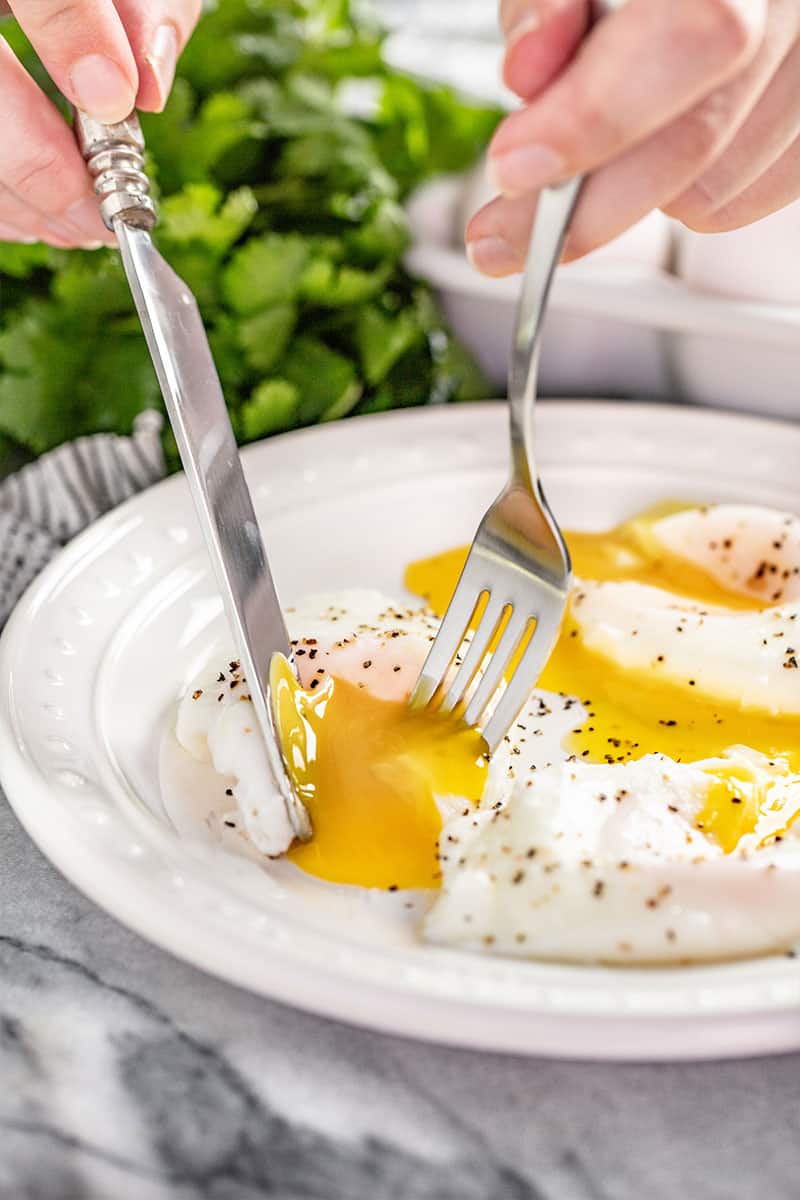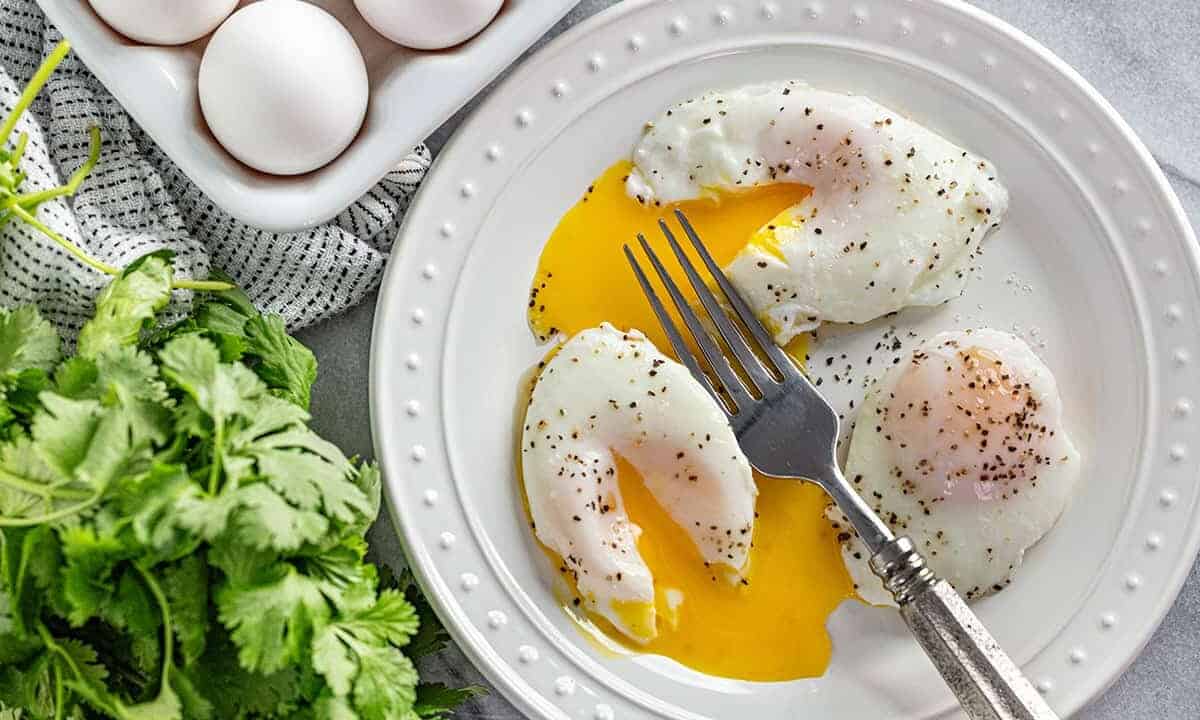Poached eggs are a delicious addition to many dishes. Don’t be afraid to try poaching an egg if you haven’t yet or haven’t been successful in the past. Follow these simple instructions for the perfect poached egg every time!

If you find yourself craving a poached egg to top your salad, or serve for brunch, don’t opt out because you’re intimidated. There is no reason to shy away from recipes that call for poached eggs. This easy method with assuage your fears and turn you into a poaching master! Poached eggs are easier to make than you might think, but well worth knowing how to cook. It is best to start with the whirlpool method and then try the skillet method when you’ve got the knack.
What is the best method for poaching eggs?
There are two popular methods for poaching eggs.
WHIRLPOOL METHOD: This method is best for cooking 1 to 2 eggs at a time. In this poached egg method you use a saucepan of gently simmering water and stir the water to create a whirlpool. The whirlpool motion will help gently wrap the egg whites around the yolk.
SKILLET METHOD: This method is best for cooking larger amounts of poached eggs at a time. In this poached egg method you use a 12-inch skillet filled with just 1 to 2 inches of simmering water. The skillet gets covered and the heat is turned off. You can comfortably poach up to 6 eggs at a time using this method.
MAKE AHEAD METHOD: You can easily cook poached eggs ahead of time using either the whirlpool or skillet method. Once the eggs are done poaching, put them in an ice bath (a bowl of water and ice) to stop the cooking process. Store in the refrigerator for up to 8 hours. When you are ready to serve, simply slide them in a pot of simmering water for 1 minute to heat through.
Should I use vinegar to make poached eggs?
Vinegar is often added to the water when making poached eggs. 1 to 2 teaspoons is all you need to add, but it is optional. Adding vinegar to the simmering water helps keep the egg whites together, but it does add a subtle tang to the finished poached egg. The swirling that the whirlpool method uses also helps the egg white to gently wrap around the yolk and keep the whites from becoming stringy.
Is it possible to make prepare poached eggs in advance?
Yes, you can cook poached eggs ahead of time! Once they are done poaching, put them in an ice bath (a bowl of water and ice) to stop the cooking process. Store in the refrigerator for up to 8 hours. When you are ready to serve, simply heat them in a pot of simmering water for 1 minute.
Poached Eggs Pro Tips:
- Use fresh eggs—this will make a big difference and help the whites to achieve the custard-like consistency you want.
- Don’t overcook the eggs. Be sure to use a timer and remove the eggs from the hot water promptly when the timer goes off.
- Always crack the eggs in small, separate dishes beforehand—this ensures that the yolk doesn’t break.
- Don’t use boiling water—keep it to a simmer to achieve the delicate texture of a great poached egg.

If this was helpful for you, here are some other how-to instructional egg recipes you might find handy:
Watch the video below where Rachel will walk you through every step of this recipe. Sometimes it helps to have a visual, and we’ve always got you covered with our cooking show. You can find the complete collection of recipes on YouTube, Facebook Watch, or our Facebook Page, or right here on our website with their corresponding recipes.


I love this method. I’ve never been very good at poached eggs and now they’re turning out perfectly. I’ve also pinned it for sharing your method and for my reference. Thank you for sharing and enabling us to pin. 🙂 Love your videos! <3
WHY CAN’T YOUR RECIPES BE PINNED WHEN YOU JUMP TO RECIPE? I PIN MOST OF YOURS, SO GOOD.
If you scroll, you will find a “P” or the word “Pin” or move your mouse over one of her photos. Rachel has made this quite easy for us to share. 🙂
The writer clearly knows what they are talking about. Main point is to use a very fresh egg & gently simmering salted water being careful about how you tip the egg into it. If you do this, swirling isn’t really needed. If your egg isn’t so fresh then make scrambled egg or omlette.
This was delicious! I was worried I wouldn’t cook it correctly, but it came out great! I served it with a salad and homemade croutons. Next time, I’ll try serving it with Rachel’s ham salad.
Those look perfect!
Hi there!
So, I can’t exactly say how well this recipe works or tastes since I am allergic to eggs, but I do want to compliment you on something, Rachel. I just want to say that you and your videos are very pleasant and enjoyable. Your smile is beautiful and I like the sound of your voice (I know it sounds weird and maybe even creepy but hear me out), I get the impression that you are a very soothing person, at least that is how you come across. You are beautiful in your own unique way and I love it! You remind me of my sister-in-law if she wasn’t so stressed always. I just want to say I really enjoy your posts and all, everybody needs encouragement and I can’t think of a better person to give credit to right now. Thank you for smiling even when the sun isn’t shining too brightly. God bless you, ma’am. 😀 Sweetly, Selah